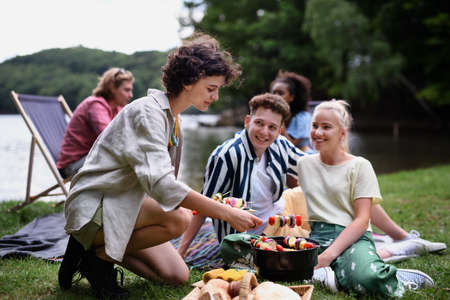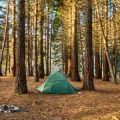Setting Up Your Outdoor Kitchen
When it comes to mastering essential outdoor cooking skills, the first step is setting up a solid outdoor kitchen. Whether you’re tailgating at a state park or backpacking miles from civilization, the right setup is crucial for safety and efficiency. Start with the basics: a reliable camp stove or fire ring, sturdy cookware, fuel, utensils, and cleaning supplies. Don’t forget essentials like a cooler or bear-proof food container if you’re in big animal country.
Safe Campsite Layout
Always pick a flat spot away from your tent—at least 50 feet—to keep flames and food smells far from your sleeping area. Position your stove or fire downwind from your gear, and have a water source or bucket of sand nearby in case things get out of hand. Avoid setting up under low-hanging branches or near dry brush to reduce fire risk.
Organizing for Efficiency
Keep your workspace tight and functional. Use a folding table or flat rock as your prep station. Store knives, spatulas, and tongs in easy reach—think carabiners or hanging gear organizers. Trash bags should be secured so critters can’t get in. If you’re going full backcountry, hang food at least 10 feet off the ground and away from camp.
Pro Tips for Any Adventure
Whether you’re grilling burgers by your truck or simmering stew over coals deep in the woods, keep cleanup gear handy and practice Leave No Trace principles. A well-organized outdoor kitchen not only makes meal prep easier but keeps everyone safer—so plan ahead and dial in your setup before you strike that first match.
2. Mastering Camp Stoves and Portable Grills
When it comes to outdoor cooking in the US, knowing how to handle camp stoves and portable grills is a game changer. These tools let you whip up everything from a classic American breakfast to a hearty fireside dinner, no matter where you set up camp. To get the most out of your gear, it’s crucial to understand your fueling options, the basics of operation, and must-know safety practices.
Fueling Options: What Powers Your Cookout?
| Fuel Type | Common Uses | Pros | Cons |
|---|---|---|---|
| Propane | Camp stoves, portable grills | Easy to use; widely available; clean burn | Cylinders can be bulky; not as eco-friendly |
| Butane | Tabletop stoves, backpacking | Lighter canisters; good for mild weather | Poor performance in cold temps |
| White Gas (Coleman Fuel) | Larger camp stoves | Performs well in cold; refillable bottles | More maintenance required; flammable handling |
| Charcoal | Portable grills | Adds smoky flavor; easy to find at stores | Takes longer to light; messy cleanup |
Operation Tips for Reliable Cooking
- Always read the user manual before first use—brands like Coleman or Weber often have unique quirks.
- Check fuel connections for leaks by applying soapy water and looking for bubbles.
- Preheat your grill or stove for 5–10 minutes for even heat distribution.
- If using charcoal, arrange briquettes in a pyramid and use a chimney starter for quick ignition—ditch lighter fluid for better-tasting food.
Sizing Up Your Equipment: What’s Right For You?
- A two-burner propane stove is ideal for family camping trips or tailgating events.
- A compact butane stove fits solo hikers or minimalist setups.
- A small kettle-style charcoal grill is perfect for backyard gatherings or park cookouts.
Safety First: Must-Know Practices
- Never cook inside your tent or enclosed spaces—carbon monoxide is deadly and invisible.
- Keep extra fuel stored away from flames and direct sunlight.
- Always extinguish coals completely and let stoves cool before packing them up.
Nail down these essentials, and youll be ready to tackle any outdoor cooking challenge America throws your way—whether you’re flipping burgers at a lakeside picnic or boiling coffee on a mountain trail.
![]()
3. Cooking Over Open Flames and Campfires
Mastering the art of cooking over open flames is a rite of passage for every outdoor enthusiast. Unlike controlled camp stoves, campfires require you to understand the fundamentals of fire building and heat management to whip up delicious, safe-to-eat meals. Start with gathering dry wood and kindling—hardwoods like oak or hickory burn hotter and longer, ideal for consistent cooking temperatures. Build a stable fire using the teepee or log cabin method, both popular choices in American campsites for their ability to provide steady heat.
Heat Management: The Secret Ingredient
One key skill is learning to manage your heat zones. Rake glowing coals to one side for high-heat searing and leave another area with fewer coals for low-and-slow cooking or keeping food warm. Experienced campers often say, “Don’t cook in the flames; cook in the coals.” This means patience—let your fire burn down until you have a bed of hot embers for even, controlled cooking.
Classic Techniques: Grilling & Foil Packet Meals
Grilling over the open fire is as American as it gets. Use a sturdy grate set over your coals for burgers, steaks, or corn on the cob. Keep an eye on flare-ups from dripping fat, moving your food to cooler zones as needed. For no-fuss cleanup, embrace foil packet meals—just wrap seasoned meat, potatoes, and veggies in heavy-duty aluminum foil, then nestle them directly in the embers. In about 30 minutes, you’ll have a hearty meal with minimal mess.
Pro Tips for Fireside Cooking
Always keep water or sand nearby to control unexpected flare-ups. Practice Leave No Trace principles by burning only local wood and making sure your fire is fully extinguished before leaving camp. With these essential skills under your belt, you’ll be able to cook up classic fireside meals safely and confidently, wherever your American adventure takes you.
4. American Campfire Classics and Easy Recipes
Nothing says “outdoor adventure” like classic American campfire meals. Whether you’re grilling on a portable stove or gathering around the fire pit, these recipes deliver big flavor and hearty satisfaction. Here’s your guide to crowd-pleasing dishes, traditional favorites, and field-tested tips for every meal in the wild.
Hearty Campfire Breakfasts
Start your day with energy-packed classics. The all-American breakfast scramble is a must: eggs, sausage, potatoes, and veggies tossed into a skillet over the flames. For something sweet, try fire-grilled cinnamon toast or pancakes cooked on a cast-iron griddle. Don’t forget cowboy coffee brewed right in the coals—strong, hot, and reliable.
| Breakfast Dish | Main Ingredients | Pro Tip |
|---|---|---|
| Campfire Scramble | Eggs, sausage, bell peppers, potatoes | Pre-chop ingredients at home for quick prep |
| Pancakes | Pancake mix, water, berries | Use a squeeze bottle for easy pouring |
| Cowboy Coffee | Ground coffee, water | Add a pinch of salt to cut bitterness |
Trail Lunches Made Simple
Lunchtime calls for meals that are portable and filling. Classic ham-and-cheese sandwiches wrapped in foil can be warmed on coals. Try tortilla wraps loaded with peanut butter and honey for a no-cook option. If you’ve got time, grill up some all-beef hot dogs—a true taste of Americana.
| Lunch Idea | Main Ingredients | Outdoor Cooking Method |
|---|---|---|
| Foil-Wrapped Sandwiches | Bread, ham, cheese, mustard | Heat on coals or portable grill |
| Tortilla Wraps | Tortilla, peanut butter, honey, banana slices | No-cook; pack and go! |
| Grilled Hot Dogs | All-beef hot dogs, buns, condiments | Roast over open fire or grill grate |
Dinners by the Fire: Comfort Food After Sundown
The sun sets and it’s time for fireside feasts. Go classic with Dutch oven chili—ground beef, beans, tomatoes simmered together for hours. Foil packet meals (think chicken with veggies and herbs) are easy to prepare and require minimal cleanup. And don’t forget s’mores: graham crackers, chocolate bars, marshmallows roasted to gooey perfection.
| Dinner Favorite | Main Ingredients | Cooking Gear Needed |
|---|---|---|
| Dutch Oven Chili | Ground beef, beans, tomatoes, onions, spices | Dutch oven over campfire coals |
| Chicken & Veggie Foil Packets | Chicken breast, mixed vegetables, herbs, olive oil | Heavy-duty aluminum foil; place on hot coals or grill grate |
| S’mores | Graham crackers, chocolate bars, marshmallows | Long roasting stick or skewer over open flame |
Pro Tips for Success:
- Prep ingredients at home to save time at camp.
- Packing multipurpose seasonings (like Old Bay or Cajun spice) amps up flavor fast.
- A good pair of heat-resistant gloves makes handling hot cookware safer.
- If using a campfire ring in public parks or U.S. Forest Service sites, follow Leave No Trace principles to protect the outdoors for everyone.
- Always keep water nearby for safety when cooking over open flames.
The Bottom Line:
Mastering these American outdoor cooking classics not only keeps your crew fueled but also turns every meal into an experience worth remembering around the campfire.
5. Food Safety and Wildlife Awareness
When you’re cooking outdoors—whether it’s on a camp stove at a national park or over an open fire deep in the backcountry—food safety is non-negotiable. Out here, keeping your meals safe and your camp critter-free is just as important as nailing that perfect s’more.
Smart Food Storage: Outsmarting Raccoons and Bears
Wild animals have noses for adventure—and for your food. In bear country, always use designated bear lockers or hang your food in a bear bag at least 10 feet off the ground and 4 feet from tree trunks. For smaller critters like raccoons and squirrels, airtight containers or hard-sided coolers with locking lids are key. Never leave snacks or trash unattended; even a granola bar wrapper can attract unwanted visitors.
Hygiene: Clean Camps Are Safe Camps
Hand sanitizer and biodegradable soap should be staples in your camp kitchen. Wash hands before prepping meals and after handling raw meat. Use separate cutting boards for meat and veggies if possible, and always cook meats to safe internal temperatures—a pocket thermometer is a solid investment. After eating, scrub all dishes promptly and pack out any food scraps to keep the site pristine (and critter-free).
Storing Leftovers Like a Pro
If you have leftovers, store them in sealed containers inside your cooler or a bear-resistant canister. Avoid eating inside your tent—crumbs can lead to midnight animal encounters you won’t forget.
Local Wildlife Awareness
Brush up on the specific wildlife hazards in the area you’re exploring. Rangers often post current warnings about animal activity—heed their advice! If bears are active, double down on precautions. In snake country, stay alert when reaching into woodpiles or brush near camp.
Mastering these guidelines will keep both your crew and the local wildlife safe, letting you focus on what matters most: enjoying great meals under the open sky.
6. Cleanup and Leave No Trace Principles
Respect the Wild: Responsible Cleanup Matters
After a satisfying meal in the wild, your job isn’t done until your camp is spotless. Practicing responsible cleanup not only preserves nature for others but also keeps wildlife safe and maintains access for future adventurers. Always plan ahead by bringing garbage bags and reusable containers to pack out all food scraps, wrappers, and waste. Don’t burn or bury trash—most items won’t fully decompose and can harm wildlife.
Practical Steps for Packing Out Waste
Start by separating food scraps from packaging, then store all waste in secure bags or bear-proof canisters. If you’re using biodegradable soap, wash dishes at least 200 feet from streams or lakes to prevent contamination. Strain dishwater to catch food particles and pack them out with your trash; scatter the remaining water away from campsites and trails.
Upholding Leave No Trace Ethics
The core of outdoor ethics is simple: leave every spot better than you found it. Stick to established fire rings or stoves to minimize impact, never pick plants or disturb animal habitats, and keep noise levels low. Before leaving camp, do a final sweep—check for micro-trash like twist ties or bottle caps that are easy to overlook. By making these habits second nature, you’ll ensure America’s wild places stay pristine for generations of outdoor cooks and explorers.


